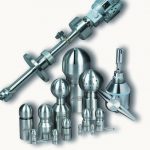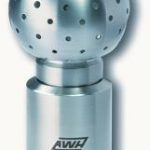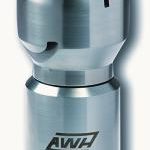In addition to simple cleanliness, growing importance is nowadays attached to efficient cleaning of vessels. Customers are consequently keen to cut down not only on operating costs but also on investment costs. Particular attention is focused on reducing both the quantity of cleaning agent and the cleaning time, in other words on increasing plant availability, improving operational reliability and enabling sensory testing methods to validate the cleaning processes.
A cleaning machine is chosen according to the nature of the application or task that has to be performed and not simply the available technology, as the optimum solution for cleaning vessels is dependent on the geometry of the vessel and on the purpose for which it is used. Account therefore needs to be taken of possible spray shad-ows due to heterogeneous installations, nozzles and manholes. The product range offered by AWH comprises a broad spectrum of devices backed up by extensive application know-how. The various types of cleaning device are described below.
Static spray head
The head type most commonly used for cleaning vessels is the static spray head with its numerous different spray patterns. The preferred patterns are 180° up and down as well as 270° down and the obligatory 360°. The Tanko represents an efficient complement to the static spray head. It combines the characteristics of a static spray ball with the benefits of a rotating spray head. The rotation of the static spray head enables faster and more uniform introduction and distribution of the cleaning agent into and inside the vessel. The Tanko, which is supplied in a clip-on version as standard (threaded and weld-on variants are optionally available), can be mounted in any position thanks to the double ball bearing drive and operated in the required orientation. This device is offered in grade 1.4435 or 1.4571 (bearing balls in 1.4401).
Surge cleaner
Precise metering of the cleaning agent is an important factor in modern plants. Econo-mical use of agent is soon rewarded through lower costs for purchasing, processing and disposal. The products in the Spinner series meet all these demands. These surge cleaners distribute the cleaning agent quickly and efficiently at the required angle. The pressure load can be adjusted with the Spinner series between 1 and 8 bar, and applications have even been realised up to 20 bar. The cleaning device is driven via the asymmetrical slots in the head. The diversity of the Spinner series allows the product to be optimally adapted to each application. All surge cleaners can be operated in any position. The standard type with a spray angle of 360° is complemented by 90° and 180° versions, whereby the latter two variants do not support reverse spraying. The cleaning agent is sprayed where it is needed in the direction of the spray angle. The choice of connections – clip-on, threaded or weld-on (e.g. orbital welding head) – mean the installation can be tailored to the requirements of any application. The Spinner series is manufactured using grade 1.4404 (bearing balls: 1.4401). The product range is rounded off by special designs with alternative connections and spray angles as well as Hastelloy models. The Atex approval extends the already broad spectrum of applications to areas in which an explosion proof design is mandatory.
Almost a jet cleaner
For many years now, the gap between surge cleaners and true jet cleaners has been filled by the products in the TRB series. These operate in a similar way to a jet cleaner, but usually boast a superior cleaning performance due to the higher impact of the cleaning agent. The rotation is produced by a special, integrated drive system. The head of each TRB incorporates various ducts and nozzles right through to the inner axis. Depending on the pressure of the cleaning agent, the jet is discharged through the nozzles sufficiently powerfully onto the surface to be cleaned. The TRB series is available in three different designs. The cheapest solution is the slow-speed model with a PTFE slide bearing. The variant with a conductive PTFE slide bearing, the version made entirely of conductive PTFE and the stainless steel type with stainless steel ball bearings are also suitable for use in hazardous areas (Atex approval).
Medium-driven jet cleaners
The performance parameters of these jet cleaners can be optimally adapted to any application. The rotary force is produced by means of the medium flow and pres-sure. This force is transferred to two axes, resulting in a true 360° rotation of the jet nozzles. The geometry of the nozzles (length and diameter), together with the pressure of the medium, determines the possible technical design. The design and selection of the most suitable system are discussed in detail with the customer. A comprehensive analysis of the cleaning tasks is an essential prerequisite of an eco-nomically viable cleaning concept.
The Orbi G4 tank cleaning machine offers a cleaning radius of more than 4 m as well as a high jet impact. After each 360° rotation, the jet begins again in a slightly different position, returning to its original starting point after 45 rotations. The Orbi G4 can be operated at a minimum medium pressure of 2 bar (max. 20 bar). The maximum volume flow rate of 7 m³/h at a maximum operating temperature of 121 °C permits extremely efficient operation in a broad range of applications.
In addition to a standard version, the Jumbo 6 is also available in a high-temperature design (up to 260 °C). The basic principle is the same as that of the Orbi G4, but the larger volume allows much greater quantities of cleaning agent to be used.
The state-of-the-art concept of the Tankmaster unites optimum cleaning results with low consumption and a permissible operating pressure of 5 to 60 bar. The rugged design of the Tankman is ideal for bulk tanks of the kind encountered in breweries and in the production of beverages. The 2 and 3-jet nozzle system allows operation with a larger quantity of cleaning agent at a pressures from 4 to 14 bar in a high-precision 360° jet system. Cleaning can thus be combined with subsequent rinsing.
Jet cleaners with external electric drive
This product group merges powerful cleaning with exceptionally low consumption of cleaning agent. Thanks to the external electric motor, no agent is required for the rotary motion. Both the rotation and the speed can therefore be easily adjusted to the cleaning process. The geometry of the jet nozzles determines the cleaning agent throughput, the system radius and thus also the potential cleaning performance. It is these systems that clean surfaces most efficiently. The product series offers a choice of three versions with either a mechanical seal or a magnetic coupling. The rugged design of the TRG series, featuring a magnetic coupling, is ideal for all applications that are subject to Atex directives or require a particularly robust mechanical system (e.g. tanker cleaning).
Extensive range of accessories
An extensive range of accessories is offered for AWH products. The cleaning ring for sight glasses, nozzles or agitating shafts facilitates circular distribution and/or introduction of liquids and gases. The cleaning system is connected to the vessel using a sterile, loose-flange fixture. A suitable loose flange recently augmented the portfolio. Rotation control systems for jet cleaners are another new addition. Methods for validating jet cleaning processes will be available in the near future. This technology will include field-proven measuring techniques with flange or nozzle-mounted instruments for the vessel as well as innovative ideas for jet detection.
Static spray heads cpp 401
Surge cleaners cpp 402
Jet cleaners cpp 403
Cleaning technology from AWH
TechnoPharm 2005
Share:









